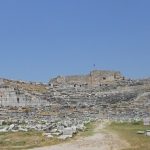The first Luwian-speaking Lycians appeared on the scene in the 13th century BC. Fiercely independent, like most of the coastal peoples they found that precious independence threatened in the sixth century by the Persians under Cyrus the Great. By then they appear to have been speaking true Lycian to judge from the inscriptions found at their first capital, Xanthos. Their history then collapses into the usual chaos of occupation after occupation; at different times this part of Anatolia was governed by Persians, Athenians, Egyptians, Macedonians and Rhodians before eventually succumbing to the Romans in 43 AD. Initially they operated as a series of city-states linked together in the largely self-governing Lycian League (formed c. 167 BC) but later they became a mere province of the Roman Empire. Their language appears to have died out in the fourth century, by which time most Lycians seem to have been speaking Greek. A few of the Lycian settlements went on to greater things but gradually most were abandoned.
The Lycians were masters of the funerary arts, leaving their mark on the landscape in the form of dramatic and picturesque rock-cut tombs carved to look like wooden houses or even miniature temples. Such tombs were the preserve of the nobility but even lesser mortals got a grand send-off in the huge sarcophagi with pitched lids that litter the ground especially at Patara and Kaleköy, near Kaş.
At its height the Lycian League seems to have consisted of 26 separate city-states, and traces of most of them survive to this day, albeit sometimes in hard-to-access locations; to find them all you’ll need a copy of Cevdet Bayburtluoğlu’s excellent Lycia guidebook. As usual, visitors to the Lycian sites need to remember that much of what they will see dates from the later Roman period.
Even non-Lycian experts can easily learn to detect their past presence in an area thanks to their distinctive funerary monuments, which come in three separate forms.
In the first place there are the plain and hefty stone sarcophagi of the type to be seen in Fethiye high street, on the outskirts of Patara, and at the top of Uzun Çarşı in Kaş.
Then there are the pretty rock-cut tombs with carved panelling that resemble older wooden prototypes; tombs like this can be seen in the necropolis at Xanthos and backing the great theatre at Myra (Demre).
Finally, and most impressively, there are the spectacular rock-cut tombs that look like delicate miniature temples that can be seen at the back of Fethiye and gazing down on the İztuzu river in Dalyan.
